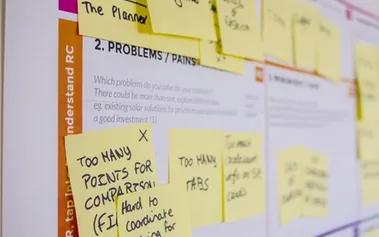What do you do when your best engineering work looks like your worst performance? My team spent six months building competitive advantages that would pay off over the next few years. The CFO wanted to know why we were "underperforming".
Welcome to the cruel irony of strategic patience in a sprint-obsessed world, where brilliant technical decisions get you performance improvement plans.
"Tom, this looks like your team's struggling" the CEO said, squinting at our velocity chart like it was written in ancient hieroglyphs. We'd built the most elegant API architecture I'd seen in my 25 years of engineering. It could handle traffic spikes that wouldn't hit us for two years and enabled features our competitors couldn't dream of matching.
But the spreadsheet told a different story. Story points down. Sprint commitments missed. I wanted to explain that we'd eliminated three years of technical debt and built competitive advantages that would compound over the next few years. Instead, I found myself apologising for "missing targets" whilst internally screaming about how velocity charts can't measure architectural brilliance.
Here's what I've learned from watching brilliant teams get penalised for thinking strategically whilst their competitors play sprint velocity bingo: we've created environments where quarterly urgency systematically destroys long-term competitive advantage. The irony is brilliant. McKinsey's analysis of 615 companies over 15 years shows that organisations maintaining strategic discipline during pressure outperform reactive competitors by 47%.
The trick isn't choosing between short-term delivery and strategic patience. It's learning to protect long-term thinking without getting fired for "underperformance". Because apparently "building competitive advantages" doesn't translate well in PowerPoint.
Why Sprint Thinking Murders Strategic Advantage
I've sat through enough quarterly reviews to recognise the pattern. Leadership preaches long-term vision in January, then panics about sprint velocity in March like they've forgotten their own strategy presentations. I've watched teams abandon platform investments that would revolutionise their capabilities because this quarter's story points looked disappointing.
The quarterly earnings cycle creates what researchers politely call "managerial myopia". I call it strategic amnesia with a side of collective memory loss. Teams start three initiatives per year instead of finishing one that actually matters. Innovation budgets vanish faster than biscuits in a developer meeting the moment quarterly metrics wobble.
"The most successful companies think in decades, not quarters. They understand that sustainable competitive advantages take years to build but can be destroyed in months through short-term thinking."
Amazon spent years losing money whilst building AWS, Prime, and their marketplace. Wall Street hated it. Bezos ignored them like a seasoned engineer ignoring "urgent" feature requests. Meanwhile, companies pivoting strategy every quarter to hit earnings targets ended up competing purely on price because they'd built nothing defensible.
The cruel irony? I've seen more careers damaged by strategic patience than strategic shortsightedness, even though the patient approach consistently wins long-term. We punish the people building our future whilst rewarding those optimising our present into irrelevance.
Teaching Stakeholders to Think Beyond This Quarter
Here's where most engineering leaders get it spectacularly wrong (and I've made this mistake more times than I care to admit, usually whilst wearing my most confident "I've got this sorted" expression). We assume stakeholders understand why strategic work matters. They don't. They see delayed features and higher costs without understanding the competitive advantages being built.
It's like explaining why refactoring matters to someone who thinks "technical debt" is what you owe on your laptop.
I've learned to use what I call the "Strategic Narrative Framework". Three arguments that help non-technical stakeholders understand why patience pays off, translated into language that doesn't make their eyes glaze over.
The Strategic Narrative Framework
Current State Costs: Don't just mention opportunity costs. Calculate them properly, like you're debugging a performance issue. When I showed our board that our legacy architecture was costing us £2M annually in developer time and missed market opportunities, suddenly that £500K platform investment looked brilliant rather than expensive. Numbers speak louder than architectural diagrams, apparently.
Investment Bridge: Connect technical work to business outcomes stakeholders actually care about. I stopped saying "we need to refactor the authentication system" and started saying "this eliminates the bottleneck that's preventing us from onboarding enterprise customers." Same work, completely different reception. Amazing how "enterprise customers" translates better than "clean code architecture".
Progress Milestones: Create measurements that prove strategic momentum without compromising long-term vision. Track capabilities built, not just features shipped. When stakeholders see that platform work enables faster future development, they stop viewing it as productivity drag and start seeing it as competitive advantage building.
The 70/30 Resource Split That Actually Works
After years of watching strategic projects get abandoned faster than abandoned shopping carts under quarterly pressure, I've adopted explicit resource allocation: 70% operational excellence, 30% strategic positioning. Both tracks get protected time and appropriate accountability, because trying to do strategic work with "leftover" time is like trying to do proper code reviews during standup meetings.
The magic happens when stakeholders understand that strategic work isn't replacing operational delivery. It's accelerating it over time. Your platform investment slows things down for six months, then doubles development speed over the next few years. It's compound interest for engineering teams.
Measuring Strategic Progress Without Losing Your Mind
Traditional sprint metrics applied to strategic work create a special kind of professional hell that would make Kafka proud. I've watched teams obsess over story points for infrastructure projects that fundamentally can't be broken into neat two-week chunks. It's like measuring poetry by word count.
Here's what I've learned about measuring strategic health after years of getting this embarrassingly wrong: track capability building, not task completion. Market positioning matters more than velocity charts. The question isn't "How many stories did we complete?" but "Are we building competitive advantages that compound over time whilst keeping everyone employed?".
Strategic Health Indicators That Actually Matter
Market Position Evolution: Track how your competitive standing changes relative to key players. This includes customer perception shifts and technical capability gaps that indicate whether you're gaining ground or watching competitors eat your lunch. Proper competitive intelligence, not just guessing based on their marketing materials.
Capability Development Progress: Measure team skills advancement and system scalability improvements that enable future opportunities. These capabilities create what I call "option value". The ability to pursue strategies competitors simply cannot access because they're still wrestling with their monolithic architecture from 2015.
Competitive Moat Deepening: Evaluate whether your strategic work makes competitive advantages harder to replicate. Network effects, switching costs, or technical expertise that compounds over the next few years, not quarters. Think less "features anyone can copy" and more "foundational advantages that take years to replicate".
The most effective approach combines these indicators with traditional metrics. You still track revenue and efficiency (because no-one likes those criticising looks from the CFO), but you also measure whether you're building capabilities that will matter over the next few years whilst keeping the quarterly reports looking respectable.
When "Long-Term Thinking" Becomes an Excuse for Bad Execution
I've also seen strategic patience become strategic procrastination disguised as wisdom. Teams that use "long-term vision" to avoid accountability faster than developers avoid writing documentation. Leaders who postpone difficult decisions indefinitely whilst claiming they're being strategic when they're actually just hoping the problems sort themselves out.
The difference between authentic strategic patience and strategic avoidance lies in intermediate progress indicators that you can actually point to without embarrassment. Real strategic work produces measurable capability building. Fake strategic work produces endless research and planning documents that nobody reads but everyone pretends are brilliant.
When Amazon invested in AWS before profitability, they tracked specific technical milestones and customer adoption metrics like proper engineers. The patience was disciplined, not wishful. They knew exactly what they were building and could demonstrate progress toward clear objectives without resorting to vague promises about "ecosystem synergies".
"Strategic patience means being willing to wait for results while being unwilling to wait to take action. The execution starts immediately even when the payoff is distant."
Warning signs I've learned to watch for like a security-conscious engineer scanning for vulnerabilities: strategic initiatives that consume resources without building measurable capabilities, teams that avoid difficult implementation decisions by calling everything a "research phase", and leaders who can't articulate intermediate milestones without using buzzword bingo.
Making This Work When You're Still Figuring It Out
I'll be brutally honest. I'm still working on this balance myself, often whilst questioning whether I've learned anything in 25 years of building teams. I've caught myself apologising for "slow progress" on a platform initiative that will accelerate everything we do in the following few years. Old habits die harder than legacy code.
Strategic patience isn't a personality trait you're born with. It's a systematic approach to protecting long-term thinking whilst delivering short-term results and keeping everyone's jobs intact.
Start with one strategic initiative currently under pressure from quarterly metrics that make no sense. Apply the Strategic Narrative Framework to explain its value in language stakeholders can understand without falling asleep. Implement the 70/30 resource split so strategic work gets protected time instead of being squeezed into "spare moments" between urgent requests.
Most importantly, establish those Strategic Health Indicators that prove long-term progress whilst keeping the velocity charts looking respectable enough to avoid awkward conversations with leadership.
Ask yourself the uncomfortable questions:
- Are you protecting strategic work from quarterly reallocation whilst maintaining proper accountability?
- Do stakeholders understand how current investments build future capabilities, or are you just hoping they trust your engineering judgment?
- Can you identify concrete milestones that demonstrate strategic momentum without requiring a computer science degree to understand?
The companies that thrive long-term master this balance whilst everyone else plays quarterly whack-a-mole with competing priorities. They think strategically whilst delivering operationally. Both timelines matter, but only when you manage them as complementary systems rather than competing priorities that give you headaches.
Our sprint-obsessed world needs leaders who can build competitive advantages that compound over time whilst keeping the lights on today.
That's not just good strategy. It's survival with style.




